THE DE-CLANG BANGER
Inspired by the complaints of a teacher, the De Clang Bang is a product meant to protect and silence your water bottle if you were to drop it.
With protective rubber bands and a cushioned bottom, the De Clang Bang fits comfortably over 12- 24 ounce bottles, though we’re working on expanding our product.
With protective rubber bands and a cushioned bottom, the De Clang Bang fits comfortably over 12- 24 ounce bottles, though we’re working on expanding our product.


